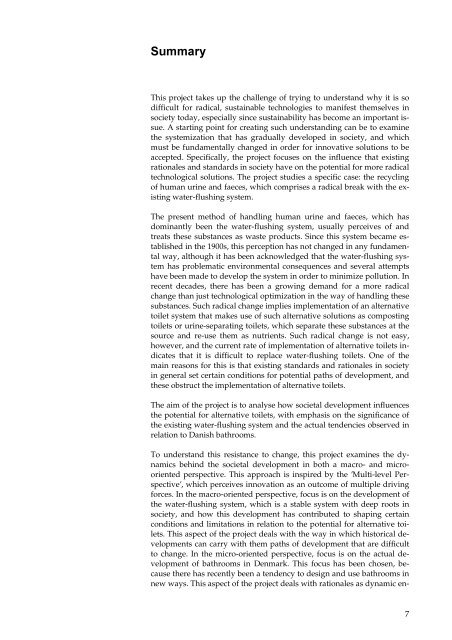Badeværelseskultur - en barriere for bæredygtig udvikling?
Badeværelseskultur - en barriere for bæredygtig udvikling?
Badeværelseskultur - en barriere for bæredygtig udvikling?
You also want an ePaper? Increase the reach of your titles
YUMPU automatically turns print PDFs into web optimized ePapers that Google loves.
6XPPDU\<br />
This project takes up the chall<strong>en</strong>ge of trying to understand why it is so<br />
difficult <strong>for</strong> radical, sustainable technologies to manifest themselves in<br />
society today, especially since sustainability has become an important issue.<br />
A starting point <strong>for</strong> creating such understanding can be to examine<br />
the systemization that has gradually developed in society, and which<br />
must be fundam<strong>en</strong>tally changed in order <strong>for</strong> innovative solutions to be<br />
accepted. Specifically, the project focuses on the influ<strong>en</strong>ce that existing<br />
rationales and standards in society have on the pot<strong>en</strong>tial <strong>for</strong> more radical<br />
technological solutions. The project studies a specific case: the recycling<br />
of human urine and faeces, which comprises a radical break with the existing<br />
water-flushing system.<br />
The pres<strong>en</strong>t method of handling human urine and faeces, which has<br />
dominantly be<strong>en</strong> the water-flushing system, usually perceives of and<br />
treats these substances as waste products. Since this system became established<br />
in the 1900s, this perception has not changed in any fundam<strong>en</strong>tal<br />
way, although it has be<strong>en</strong> acknowledged that the water-flushing system<br />
has problematic <strong>en</strong>vironm<strong>en</strong>tal consequ<strong>en</strong>ces and several attempts<br />
have be<strong>en</strong> made to develop the system in order to minimize pollution. In<br />
rec<strong>en</strong>t decades, there has be<strong>en</strong> a growing demand <strong>for</strong> a more radical<br />
change than just technological optimization in the way of handling these<br />
substances. Such radical change implies implem<strong>en</strong>tation of an alternative<br />
toilet system that makes use of such alternative solutions as composting<br />
toilets or urine-separating toilets, which separate these substances at the<br />
source and re-use them as nutri<strong>en</strong>ts. Such radical change is not easy,<br />
however, and the curr<strong>en</strong>t rate of implem<strong>en</strong>tation of alternative toilets indicates<br />
that it is difficult to replace water-flushing toilets. One of the<br />
main reasons <strong>for</strong> this is that existing standards and rationales in society<br />
in g<strong>en</strong>eral set certain conditions <strong>for</strong> pot<strong>en</strong>tial paths of developm<strong>en</strong>t, and<br />
these obstruct the implem<strong>en</strong>tation of alternative toilets.<br />
The aim of the project is to analyse how societal developm<strong>en</strong>t influ<strong>en</strong>ces<br />
the pot<strong>en</strong>tial <strong>for</strong> alternative toilets, with emphasis on the significance of<br />
the existing water-flushing system and the actual t<strong>en</strong>d<strong>en</strong>cies observed in<br />
relation to Danish bathrooms.<br />
To understand this resistance to change, this project examines the dynamics<br />
behind the societal developm<strong>en</strong>t in both a macro- and microori<strong>en</strong>ted<br />
perspective. This approach is inspired by the ’Multi-level Perspective’,<br />
which perceives innovation as an outcome of multiple driving<br />
<strong>for</strong>ces. In the macro-ori<strong>en</strong>ted perspective, focus is on the developm<strong>en</strong>t of<br />
the water-flushing system, which is a stable system with deep roots in<br />
society, and how this developm<strong>en</strong>t has contributed to shaping certain<br />
conditions and limitations in relation to the pot<strong>en</strong>tial <strong>for</strong> alternative toilets.<br />
This aspect of the project deals with the way in which historical developm<strong>en</strong>ts<br />
can carry with them paths of developm<strong>en</strong>t that are difficult<br />
to change. In the micro-ori<strong>en</strong>ted perspective, focus is on the actual developm<strong>en</strong>t<br />
of bathrooms in D<strong>en</strong>mark. This focus has be<strong>en</strong> chos<strong>en</strong>, because<br />
there has rec<strong>en</strong>tly be<strong>en</strong> a t<strong>en</strong>d<strong>en</strong>cy to design and use bathrooms in<br />
new ways. This aspect of the project deals with rationales as dynamic <strong>en</strong>-<br />
7

















